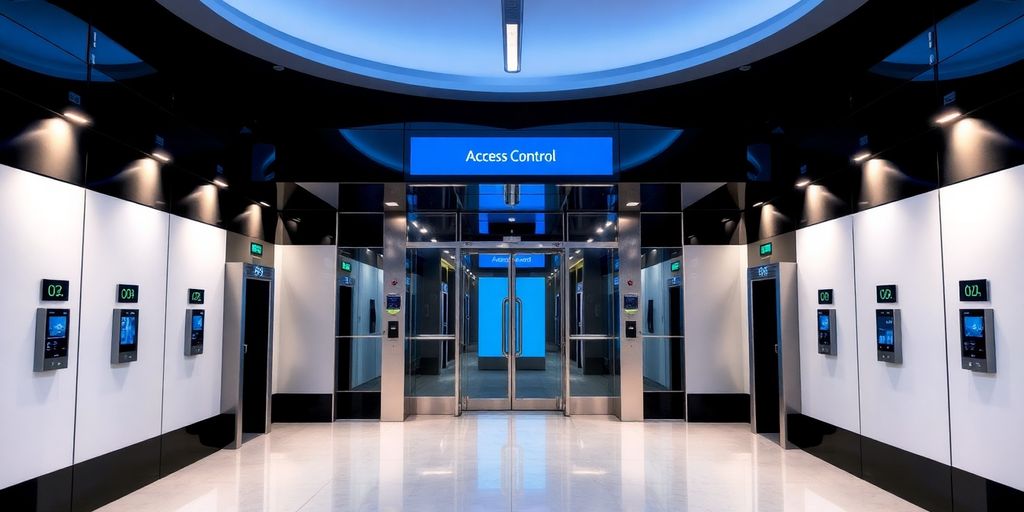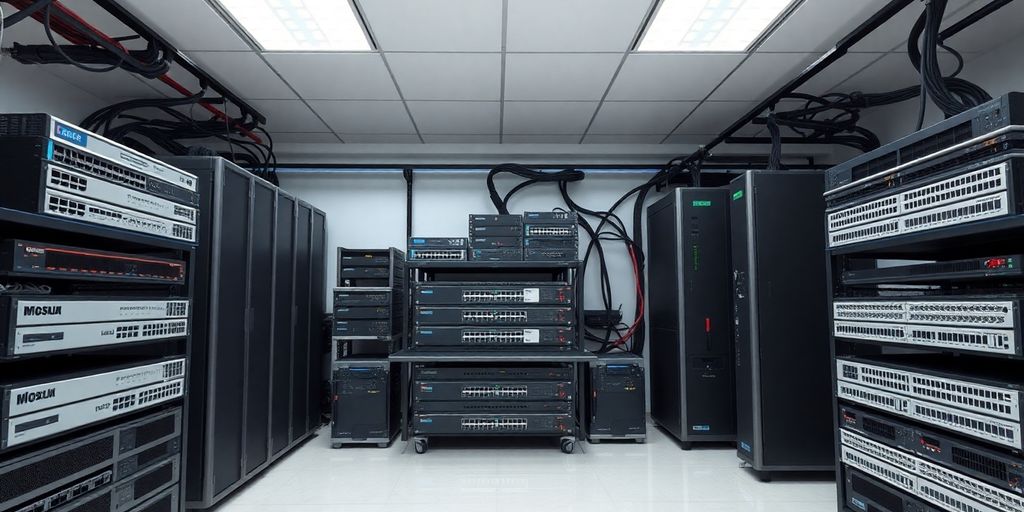Access control is changing fast, with new tech making it safer and simpler to manage who enters and exits buildings. As we head into 2024, businesses are looking for ways to make these systems work better with our flexible work styles. It’s all about making things smoother and more secure, whether you’re at the office or working remotely. Let’s check out some cool new trends that are shaking up access control facilities.
Key Takeaways
- Biometric tech like facial and fingerprint recognition is getting better and more secure.
- Touchless access is on the rise, making it easier and safer to enter buildings without touching anything.
- Remote management tools let you control access from anywhere, which is great for hybrid work setups.
- Cybersecurity is a big deal now, especially with more data being used in access systems.
- AI is helping automate access control, making it smarter and more efficient.
Biometric Innovations in Access Control Facilities
Advancements in Facial Recognition Technology
Facial recognition technology is taking big strides, making it faster and more accurate. Enhanced algorithms are reducing false positives, making systems more reliable. Companies are focusing on refining facial recognition to ensure it works smoothly even in low light or with changes in appearance, like glasses or hairstyles.
Integrating Fingerprint and Iris Scanning
Combining fingerprint and iris scanning into one system is becoming popular. This multi-modal approach strengthens security by using two unique identifiers instead of one. It’s like having a double lock on your door. More facilities are adopting these systems as they provide a robust security layer.
Ensuring Data Privacy in Biometric Systems
With great power comes great responsibility. As biometric systems gather more personal data, protecting this information is crucial. New systems are being designed with strong encryption and data protection features. This ensures that while the systems are secure, they also respect users’ privacy.
The world of biometrics in access control is not just about keeping unauthorized people out; it’s about creating a seamless and secure experience for everyone involved. As these technologies evolve, they promise to make our spaces safer without compromising on convenience.
The Rise of Touchless Access Control Solutions
In 2024, touchless access control solutions are becoming a game-changer in security systems. These systems are not only about keeping places secure but also about making life easier for everyone. Touchless technology is now a must-have for areas with lots of foot traffic, like offices and public spaces. The shift from traditional methods to touchless solutions is driven by the need for hygiene and convenience.
Implementing Motion Sensing Technology
Motion sensing technology is at the heart of touchless systems. It works by detecting specific movements, like a hand wave, to unlock doors. This means no more fumbling for keys or cards. It’s all about making access swift and straightforward. By reducing physical contact, these systems also help prevent accidental unlocks, which is a big plus for security.
Enhancing Mobile Credential Experiences
Mobile credentials are transforming how we think about access control. Your smartphone can now act as a digital key, making it easier to enter secured areas without needing physical cards. This technology is not just about convenience; it also offers robust security features. With mobile credentials, you can enjoy a seamless entry experience, and it’s all managed through apps that are easy to use.
Reducing Physical Contact in High-Traffic Areas
Reducing physical contact in busy areas is more important than ever. Touchless systems help by eliminating the need to touch common surfaces like doorknobs or keypads. This is especially crucial in places with high foot traffic, where hygiene is a top priority. By using technology that requires no direct contact, these systems help maintain a cleaner and safer environment for everyone.
As 2024 concludes, a new tool is introduced to enhance security, convenience, and efficiency for properties, reflecting a commitment to innovation and improvement. Learn more about this innovative tool that is changing the way we think about access control systems.
Remote Management and Its Impact on Access Control
Benefits of Remote Access for Hybrid Work Models
Remote management in access control is a game-changer for businesses, especially with the rise of hybrid work models. Organizations can now manage security from anywhere, making it easier to adapt to flexible work environments. This approach allows businesses to keep operations running smoothly, even when employees are working from home or different locations.
- Flexibility: Adjust access permissions without needing to be on-site.
- Efficiency: Respond quickly to security incidents regardless of physical location.
- Scalability: Easily manage multiple sites from a single platform.
Challenges in Ensuring Secure Remote Unlocks
While remote access offers many benefits, it also presents some challenges. One major concern is ensuring that only authorized individuals can perform remote unlocks. This requires robust verification processes to prevent unauthorized access. Security teams must implement strict protocols and leverage technologies like access control software to maintain high security standards.
- Verification: Implement multi-factor authentication for remote unlocks.
- Monitoring: Use real-time alerts to track access attempts.
- Integration: Combine video surveillance with access control for enhanced verification.
Integrating Video Surveillance with Remote Access
Integrating video surveillance with remote access control enhances security by providing visual verification of access attempts. This combination allows security personnel to verify identities and ensure that access is granted only to the right individuals. It’s a critical step in addressing the vulnerabilities associated with remote management.
By merging video surveillance with remote access control systems, businesses can achieve a higher level of security and operational efficiency, ensuring that access is granted safely and accurately.
Cybersecurity and Access Control Convergence

Protecting Data in Transit with Encryption
Data flying across networks is like a juicy target for cybercriminals. Encrypting this data is a must to prevent snoopers from grabbing sensitive info. Think of it like wrapping your lunch in a secure container before heading out. Without encryption, your data is exposed, and that’s a big no-no. So, using strong encryption protocols is key to keeping your data safe during its journey.
Merging IT and Physical Security Systems
The line between IT and physical security is blurring. Imagine your office badge also being a key to your digital workspace. By combining these systems, companies are creating a more streamlined and secure environment. This integration helps in managing who gets access to what, both physically and digitally, ensuring a more cohesive security strategy. It’s like having one master key for all doors, both real and virtual.
Addressing Cyber Threats in Access Control
Access control systems are no longer just about keeping doors locked. They’re now a critical part of a company’s cybersecurity plan. With threats evolving, these systems need to be robust against cyber attacks. This means incorporating features like multi-factor authentication and real-time monitoring to detect and block unauthorized access attempts. It’s about staying one step ahead of the bad guys and protecting your assets from all angles.
In a world where cyber threats are becoming more sophisticated, the convergence of cybersecurity and access control is not just a trend—it’s a necessity. By merging these two, businesses can create a more resilient and comprehensive security strategy.
The Role of AI and Machine Learning in Access Control
Automating Security Processes with AI
Artificial Intelligence (AI) is transforming how security processes are managed, making them faster and more efficient. AI automates tasks that were once manual and time-consuming, like monitoring video feeds and managing access attempts. This automation reduces human error and allows security teams to focus on more critical tasks. AI systems can also set predefined rules to trigger alerts or lockdowns when unusual activity is detected, helping to prevent incidents before they escalate.
Predictive Analytics for Threat Detection
AI and Machine Learning (ML) bring predictive capabilities to access control systems. These technologies analyze vast amounts of data to identify patterns and predict potential threats. By flagging anomalies, AI helps security teams respond quickly to suspicious activities. Currently, only 22% of end users are leveraging AI to improve the accuracy of threat detection and prediction in their security programs. This predictive intelligence allows for proactive security measures rather than just reactive responses.
Enhancing User Experience with Smart Automation
AI doesn’t just improve security; it also enhances the user experience. Smart automation can streamline access control processes, making them more user-friendly. For example, AI can integrate with mobile credentials, allowing for seamless entry without the need for physical keys or cards. This not only simplifies access for authorized users but also reduces bottlenecks at entry points, especially in high-traffic areas.
As access control systems evolve, AI and ML are not just about increasing security—they’re about creating a seamless and efficient experience for users. With AI, security becomes less about barriers and more about intelligent, user-friendly solutions.
Cloud-Based Access Control Systems
Scalability and Flexibility of Cloud Solutions
Cloud-based access control systems have become a game-changer for businesses looking to manage security across multiple locations. With 94% of companies using cloud technology, it’s clear that this trend is here to stay. These systems offer incredible scalability, allowing businesses to easily adjust their security measures as they grow. Whether you’re managing a small office or a sprawling network of buildings, cloud solutions make it easy to add or remove access points without a hitch. Plus, the flexibility of these systems means you can monitor and control access from anywhere, at any time.
Ensuring Data Security in Cloud Environments
Security is a top concern when it comes to cloud-based systems. Companies need to ensure that sensitive data is protected as it moves between devices and the cloud. Using encryption and other security measures, these systems can safeguard data in transit and at rest. However, not all industries can rely entirely on cloud solutions due to strict security protocols. In such cases, hybrid cloud systems offer a balanced approach, combining the best of both worlds by integrating cloud capabilities with on-premise infrastructure.
Integrating Cloud with Legacy Systems
One of the biggest challenges in adopting cloud-based access control is compatibility with existing legacy systems. Many organizations hesitate to make the switch because of the potential disruption to their current operations. However, hybrid cloud solutions can bridge this gap by allowing companies to connect their old systems with new cloud-based platforms. This integration ensures that businesses can take advantage of modern technology without having to completely overhaul their existing infrastructure. By doing so, they can enjoy centralized control and improved security insights across all their locations.
Cloud-based access control systems are not just a trend—they’re reshaping the way businesses think about security. With the right approach, companies can leverage these systems to create a more secure, efficient, and flexible security framework for the future.
Unified Security Systems for Enhanced Efficiency
Benefits of Interoperable Security Platforms
Unified security systems have become a game-changer for businesses, especially those dealing with complex environments like data centers. By integrating various security tools—like cameras, access controls, and visitor management systems—into a single platform, organizations can streamline their operations. This interconnectedness not only simplifies security management but also boosts overall system efficiency.
- Simplified Management: Managing multiple security tools from one interface reduces the complexity and time spent on administrative tasks.
- Improved Response Times: With systems working together, security teams can respond more quickly to incidents.
- Cost Efficiency: Reducing the number of separate systems can lower both initial setup costs and ongoing maintenance expenses.
Streamlining Operations with Unified Systems
The shift to unified security systems is largely driven by a need to simplify the security tech stack. As businesses evolve, so do their security needs, often requiring a mix of old and new technologies. A unified system allows for seamless integration, ensuring that everything works together smoothly.
- Integration of Legacy Systems: Older systems can be integrated with new technologies, providing a comprehensive security solution without the need for a complete overhaul.
- Scalable Solutions: As a company grows, its security system can expand without significant additional costs.
- Enhanced Collaboration: Unified platforms facilitate better communication and coordination among different security teams.
Future-Proofing with Open Technology Standards
Adopting open standards in security systems ensures that they remain adaptable to future technological advancements. This is crucial for companies looking to stay ahead in the ever-evolving security landscape.
- Adaptability: Open standards allow systems to easily incorporate new technologies and upgrades.
- Vendor Flexibility: Companies aren’t locked into a single vendor, providing more options and competitive pricing.
- Long-Term Viability: Systems built with open standards are more likely to remain relevant and functional as technology evolves.
Embracing a unified security approach not only enhances efficiency but also prepares organizations for future challenges by fostering a more adaptable and resilient security environment.
The Evolution of Multi-Factor Authentication

Combining Biometrics with Traditional Methods
In today’s world, relying on a single password just doesn’t cut it anymore. Multi-factor authentication (MFA) is stepping up as a game-changer, especially with the rise of phishing and password attacks. By combining biometrics like fingerprints and facial recognition with traditional methods such as passwords or PINs, MFA makes it way harder for unauthorized folks to sneak in. Imagine using your fingerprint along with a password to access sensitive data—it’s like having two locks on your door instead of one.
Enhancing Security with Multi-Layered Approaches
MFA isn’t just about adding layers for the sake of it. It’s about creating a robust defense against cyber threats. Companies are now using a mix of mobile authentication, key cards, and even physical tokens to secure high-risk areas. Here’s a quick rundown of a typical multi-layered security setup:
- Mobile Authentication: Use of FaceID or passcodes.
- Key Cards: Physical cards that add an extra layer of security.
- PIN Codes: A simple yet effective method to double-check identity.
These layers work together to make sure that if one method fails, others are there to back it up.
User-Friendly MFA Solutions for Access Control
Let’s face it, nobody likes complicated security measures. The goal is to make MFA as user-friendly as possible. This means creating solutions that are easy to use while still being secure. For instance, using a smartphone app that sends a quick notification to approve a login attempt. It’s all about making security seamless without compromising on protection.
As access control technology advances, the balance between security and usability becomes more crucial. The aim is to protect without creating barriers that frustrate users.
Conclusion
As we look ahead to 2024, it’s clear that access control is not just about keeping doors locked. It’s about creating a seamless, secure, and efficient environment that meets the needs of today’s dynamic workspaces. With the rise of biometric systems, remote management, and touchless technology, companies are finding new ways to integrate security into everyday operations without sacrificing convenience. The blending of physical and digital security measures is setting the stage for a future where access control is smarter and more adaptable than ever. As these trends continue to evolve, businesses must stay agile and open to adopting these innovative solutions to ensure they remain competitive and secure in an ever-changing landscape.
Frequently Asked Questions
What are some new trends in access control for 2024?
In 2024, access control is moving towards touchless solutions, better biometric systems, and cloud-based management. These changes help make buildings safer and more efficient.
How does biometric access control work?
Biometric access control uses things like fingerprints and facial recognition to let people into buildings. It’s like using your face or finger as a key!
Why is touchless access control important?
Touchless access control is important because it helps reduce germs by not needing to touch anything. It’s safer and faster for everyone.
What is remote management in access control?
Remote management lets people control who gets into a building from far away. It’s helpful for managing security without being on-site.
How does AI help in access control systems?
AI helps by making security systems smarter. It can predict problems and make sure everything runs smoothly without much human help.
What is multi-factor authentication in access control?
Multi-factor authentication means using more than one way to prove who you are, like a password and a fingerprint. It’s a safer way to keep things secure.



